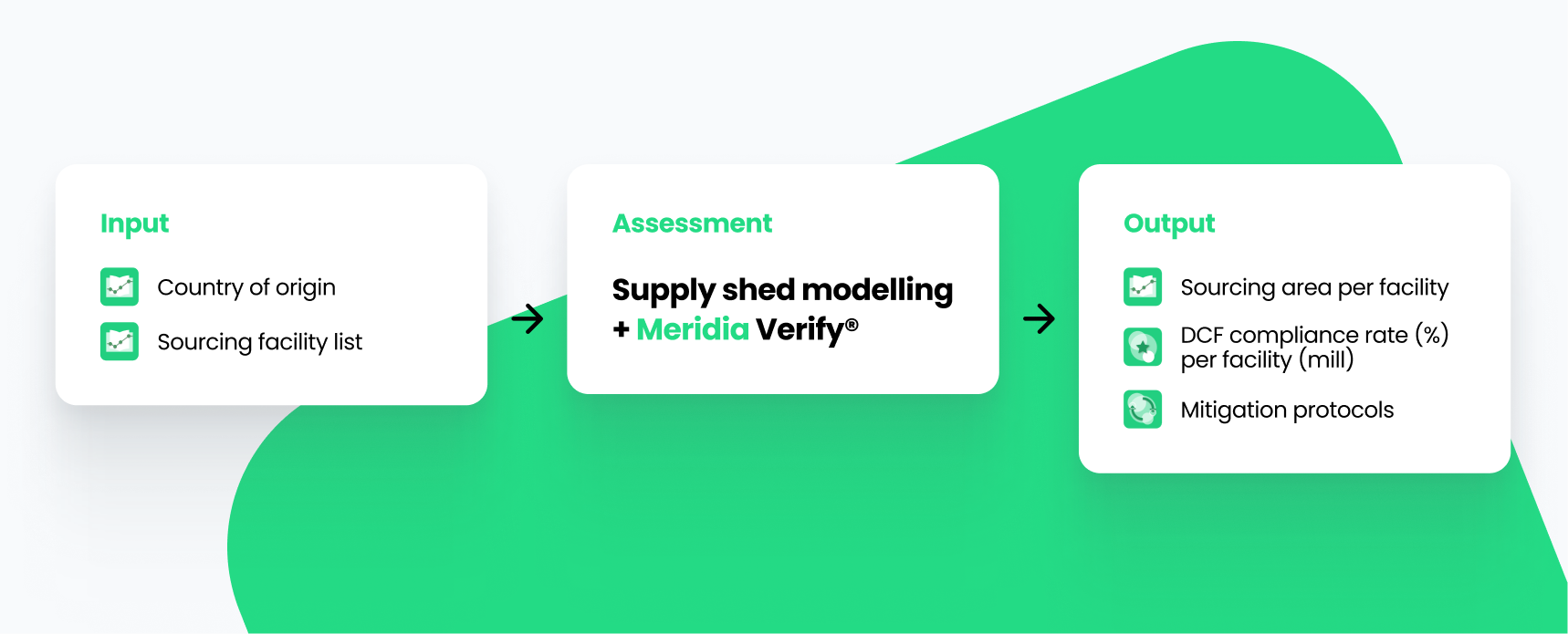Verify for Deforestation and Conversion-Free (DCF) commitments helps you identify deforestation or conversion risks within your palm supply chain, across forests and non-forest ecosystems, such as savannahs and wetlands.
However, results are only as good as the data inserted, and several issues can prevent this data from tracing commodities back to the plantation is available.
Limited access to farm-level data
Fragmented supplier tiers and reluctance to share data make traceability to the plantation through farm mapping impractical for most downstream companies.
Unstable and informal supply chains
Unstable and constantly shifting supply relationships make static mapping ineffective.
Without a stable sourcing pattern, traditional mapping becomes obsolete almost as soon as it’s completed.
High cost and upkeep burden
Mapping every farm is expensive, and frequent updates to keep pace with changes make it unsustainable at scale. They need to be updated to remain accurate due to farm turnover, changes in planting areas, or supplier switching.
Supply sheds provide a practical solution to overcome these challenges and obtain the high-quality data necessary for trusted risk assessments.

What are supply sheds?
A supply shed is a geographically defined sourcing area that provides raw materials to a specific facility, trader, or market. Instead of tracing every product back to an individual farm, supply sheds focus on the broader catchment zone where suppliers operate, while maintaining the accuracy level of individual-farm mapping.
Sustainability risk assessments, even when lacking precise farm-level data
This approach is especially valuable in industries where many smallholders lack mapped farm boundaries or digital records, allowing companies to group suppliers regionally and conduct meaningful sustainability risk assessments even when precise farm-level data is unavailable.
Cost-effective monitoring
Supply sheds function by integrating spatial data with supply chain information to define potential areas that supply raw materials to a facility, such as a mill or trader, making it the most cost-effective way to achieve traceability-to-plot (TTP).
Supply sheds vs other approaches
.png)
Area-based monitoring
One type of area-based monitoring is jurisdictional. This approach examines large administrative regions, such as provinces, districts, or municipalities. The other is to apply buffer areas. These are spatial zones around potential production areas—usually circles—used when farm-level data is unavailable, but the sourcing mills are known, allowing the estimation of deforestation or conversion risks by analysing whether any land conversion has occurred within these surrounding areas, rather than proving compliance at the plantation level.
While useful for broad risk assessments and high-level oversight, area-based monitoring often lacks the granularity needed to identify sensitive hotspots or localised environmental and social issues. As a result, it can overlook critical risks occurring within smaller landscapes or specific supply zones.
Farm-plot level traceability
This is the most precise and auditable method, mapping the boundaries of each individual farm plot and linking it to an individual producer. It offers excellent transparency and detail, enabling direct verification of compliance and sustainability claims. However, farm-plot mapping is costly, technically challenging, and resource-intensive, especially in highly fragmented, smallholder-dominated supply chains, making it impractical at scale for many companies, particularly those that are further downstream.
Supply shed modelling
Supply sheds provide an accurate yet cost-effective and scalable solution. It leverages locally available data to model the actual supply catchment areas, balancing detail and operational feasibility. This approach enables companies to focus on specific landscapes or supply regions that matter most, without the overwhelming costs of generating farm-level traceability by mapping every farm plot on the ground, making it particularly suitable for fragmented, resource-constrained supply chains and for downstream manufacturers and retailers who often lack access to plantation-level data.
Meridia’s accurate supply shed modelling
Meridia’s supply shed modelling is a critical preparation step that transforms client sourcing data into verified, spatially explicit sourcing footprints, enabling accurate, real-time Deforestation and Conversion-Free (DCF) compliance monitoring through Verify for palm supply chains.
Evidence-based sourcing sheds
We have built the most sophisticated supply shed modelling on the market, delivering the highest value of precision for sustainability and due diligence. Our solution replaces crude distance buffers with evidence-based sourcing sheds constructed from facility capacity, actual catchment patterns, trade flows, and detailed land-use data, resulting in realistic, actionable sourcing maps rather than simplistic circles on a map.
Connects compliance and performance
Meridia’s modelling directly connects compliance and performance, attributing risk and impact at the landscape level and linking these findings to specific facilities and volumes, enabling targeted interventions, transparent mitigation, and credible reporting. The system is scenario‑ready, supporting “what‑if” analyses on sourcing shifts, supplier changes, or policy constraints. This enables clients to confidently compare trade-offs among risk, cost, and operational feasibility.
Verify for DCF
The output of supply shed modelling feeds directly into Meridia Verify, which provides ongoing, audit-ready DCF risk assessments. Verified supply sheds define sourcing areas per facility and calculate DCF-compliant volume claims, even when farm-level polygons are unavailable or incomplete.
The integrated delivery model
Clients provide the country of origin and lists of sourcing facilities. Meridia’s supply shed modelling aggregates and allocates supplier volumes spatially, delivering precise sourcing footprints. These feed into Verify, which combines environmental risk maps, legality data, and compliance rules to generate continuous DCF risk insights, prioritising suppliers and enabling targeted remediation.
Output
- High sourcing accuracy: mill supply linked only to defined areas modelled by trusted data and optimisation logic
- No double counting: production is distributed only once based on optimised allocation
- Reduced uncertainty: fewer gaps and doubts in the sourcing pattern
The accuracy of supply shed modelling results depends on data availability and the methodology used in each region. The output is not fully segregated. Mixing is still possible under mass balance.
Delivery model

Benefits and impact
- High sourcing accuracy: Mill supply is linked only to definable areas using trusted data and optimisation logic.
- No double counting: Production volumes are distributed only once, reflecting optimised allocation across supply sheds.
- Reduced uncertainty: Fewer gaps and uncertainties in sourcing patterns enable more reliable risk assessments.
- Inclusivity: Enables the inclusion of smallholders who might otherwise be excluded due to data gaps, thereby advancing sector-wide sustainability.
- Efficiency: Enables quicker and more cost-effective monitoring of large landscapes than farm-by-farm mapping.
- Flexibility: Supply shed modelling bridges the gap between mass-balance models and expensive, resource-intensive farm-level mapping, making it suitable for highly fragmented supply chains and environments with limited data.
Meridia's supply shed modelling is a comprehensive answer for companies seeking scalable, credible, and inclusive traceability and sustainability solutions in today's complex global supply chains.
Meridia’s supply sheds: your accurate sourcing footprint
- Flexible by design: Annual licensing avoids heavy upfront costs and enables a responsive, renewable model that adapts to shifting priorities.
- Live intelligence: We apply system-wide learnings to improve pipelines, models, and QA. Each licence cycle delivers smarter, more robust data.
- Support built in: Licensing includes updates like mill replacements, supply reallocations, and maintenance. Everything stays operational, current, and aligned with purpose.
.png)

